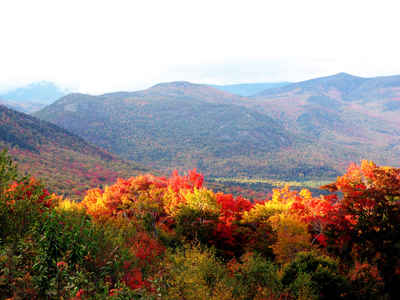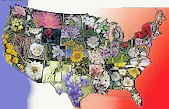New Hampshire State Flower
Purple Lilac

(Syringa vulgaris)
Adopted on May 28, 1919.
The purple lilac, (Syringa vulgaris,) was adopted as the state flower of New Hampshire on May 28, 1919. Purple Lilac is popular for its beauty and fragrance.
New Hampshire historian Leon Anderson writes in To This Day that the purple lilac was first imported from England and planted at the Portsmouth home of Governor Benning Wentworth in 1750. It was adopted as our state's flower in 1919.
That year bills and amendments were introduced promoting the apple blossom, purple aster, wood lily, Mayflower, goldenrod, wild pasture rose, evening primrose and buttercup as the state flower. A long and lively debate followed regarding the relative merits of each flower. The purple lilac was ultimately chosen, according to Anderson in New Hampshire's Flower - Tree - Bird because it "is symbolic of that hardy character of the men and women of the Granite State."
New Hampshire Revised Statute Annotated (RSA) 3:5
Anderson, Leon. Flower - Tree - Bird
State Wildflower. The pink lady's slipper, Cypripedium aca
New Hampshire State Flower: Purple Lilac

Syringa vulgaris (lilac or common lilac) is a species of flowering plant in the olive family Oleaceae, native to the Balkan Peninsula, where it grows on rocky hills.
Lilac is a common flowering shrub that grows best in a sunny location. The plant grows in shade, but flowering is poor and powdery mildew is likely to be severe. Common lilac grows 20 feet tall and spreads 15 feet. The growth rate is rapid and the plant produces many suckers. The flowers are in shades of purple, white or pink. Some colors listed in catalogs refer to the unopened flower buds. Flower bud color may be different from the flower color. There are few actual color variations.
Identification of the Purple Lilac
- Leaf: Opposite, simple, broadly ovate, 2 to 4 inches long, 1 1/2 to 3 inches, heart shaped, entire, dark green to bluish-green above, lighter
below.
- Flower: Light purple, pink or even white (cultivar dependent), fragrant, flowers in terminal clusters, 4 to 7 inches long, appearing in
May.
- Fruit: Dry, brown, capsules, 1/2 inch long.
- Twig: Stout, angled (almost 4 sided) or ridged, lustrous brown, glabrous, numerous raised lenticels, leaf scars raised, crescent-shaped,
buds large, green but turning purple in the winter.
- Bark: Gray to gray-brown, smooth but becoming finely shreddy when large.
- Form: A multi-stemmed, suckering, tall shrub reaching up to 15 feet in height.
The New Hampshire Revised Statutes
The law designating the purple lilac as the official New Hampshire state flower is found in the New Hampshire Revised Statutes, Title 1, Chapter 3, Section 3:5.
Title I: The State and Its Government.
Chapter 3: State Emblems, Flag, Etc.
SECTION 3:5.
3:5 State Flower. - The purple lilac, Syringa vulgaris, is the state flower of New Hampshire.
Source. 1919, 148:1. PL 8:3. RL 13:3.
Taxonomic Hierarchy: Purple Lilac
Kingdom: Plantae - Plants
Subkingdom: Tracheobionta - Vascular plants
Superdivision: Spermatophyta - Seed plants
Division: Magnoliophyta - Flowering plants
Class: Magnoliopsida - Dicotyledons
Subclass: Asteridae
Order: Scrophulariales
Family: Oleaceae - Olive family
Genus: Syringa L. - lilac
Species: Syringa vulgaris L. - common lilac
State Floral Emblems








